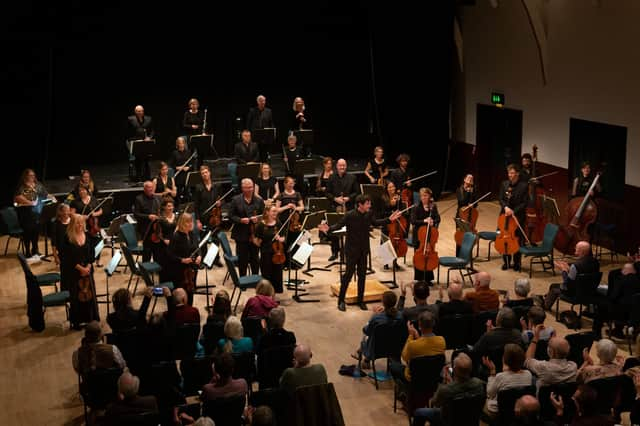Highland orchestra debuts late works by Wagner


What’s the connection between Richard Wagner and the Scottish Highlands ? You won’t find it among his operas, other than perhaps his original intention to set The Flying Dutchman in Scotland, ultimately discarded in favour of Norway.
But a new CD, showcasing a symphony by British composer Matthew King, built around themes Wagner scribbled down late in life and made known to us through his wife Cosima’s notebooks, introduces not one but two connections to the controversial 19th century operatic icon.
Advertisement
Hide AdAdvertisement
Hide AdThe recording is the brainchild of conductor Tomas Leakey and his Highlands-based chamber orchestra The Mahler Players, the semi-professional ensemble he founded in 2013, which has been performing hugely ambitious programmes – Mozart, Mahler, Stravinsky, Schoenberg, Wagner, you name it – utilising mostly local musicians for whom performance opportunities had previously been scarce. The group has been described once as “Scotland’s best kept musical secret”, and Richard Wagner in Venice: A Symphony is the their debut album.
The orchestra frequently perform in Strathpeffer Pavilion, and it’s here that the Wagner project was recorded. “We discovered by chance that it had this direct architectural connection with Bayreuth, Wagner’s iconic Festspielhaus,” Leakey explains. “The architect commissioned to build it based it on a building in Baden Baden, which itself was based on the Festspielhaus. The Pavilion opened in 1881, just six years later, so we have this little Bayreuth in the Highlands.”
More importantly, we now have this intriguing curiosity, a symphony that Wagner never wrote, but the themes of which were drafted, according to Cosima’s diaries, with the clear intention of retiring from opera and focusing exclusively on instrumental works.
In 1878, while working on his final opera, Parsifal, Cosima noted that “nothing comes into his head but cheerful themes for symphonies”. By 1882, when Parsifal was finally complete, she documented discussions between him and her equally-famous father, Franz Liszt, on where the future of the symphony lay. “Let us stop contrasting one theme with another, a method Beethoven has exhausted. We should just spin a melody until it can be spun no further; but on no account drama!” By 1883, Wagner had died in Venice.
These revelations provided the inspiration for King’s 20-minute symphonic “spin”, as did Wagner’s famous 1870 birthday present to Cosima, the Siegfried Idyll – an earlier, completed move by Wagner into symphonic intimacy which also features on this warm-hearted recording. With little to go on other than an inventory of themes, the result of King’s imagined solution is unpretentiously and convincingly Wagnerian.
The opening bars – a series of aching sighs – echo the unmistakable questioning of Tristan und Isolde. Before long, the noble influence of Parsifal (later quoted) makes its presence felt in fast-shifting, side-stepping modulations and endless dreamlike, rhapsodic denouements.
But there are numerous surprises. Amid sumptuous stylistic parallels with the Siegfried Idyll are prophetic dissonant projections that momentarily hint of Mahler. Where might Wagner have taken us had he pursued this symphonic course? That question – as in the late Anthony Payne’s completion of Elgar’s Third Symphony – is left tantalisingly moot. The symphony ends, quoting Liszt, with the elusive mystery of a Hitchcock soundtrack.
Advertisement
Hide AdAdvertisement
Hide AdLeakey and his ensemble do considerable justice to King’s speculative curiosity, capturing the lushness of the string writing and a malleability of tempi that never once interrupts the flow. There are minor discrepancies in intonation, but the all-consuming spirit of the performance overrides that. It’s a very fine debut album from an enterprising group.
Ironically, it might never have happened but for Covid. “We couldn’t get together to perform publicly, as social distancing left no space for audiences,” says Leakey. “However, it pushed us to do the recording, helping us make this unique project more widely known.” September’s live premiere in Strathpeffer marked the orchestra’s return to live performance.
And what next for The Mahler Players? After Mozart’s last three symphonies in December, it’s hopefully back to Wagner and Act 2 of Tristan. The Wagnerian connection is secured.
The Mahler Players’ debut album, Wagner in Venice: A Symphony, is available via www.mahlerplayers.co.uk
A message from the Editor:
Thank you for reading this article. We're more reliant on your support than ever as the shift in consumer habits brought about by coronavirus impacts our advertisers.
If you haven't already, please consider supporting our trusted, fact-checked journalism by taking out a digital subscription at https://www.scotsman.com/subscriptions